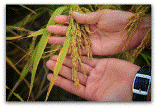Plant Pathology, Department of

Fungal Molecular Plant-Microbe Interactions
Date of this Version
2009
Document Type
Article
Citation
Molecular Plant–Microbe Interactions (2009) 22(7): 882–894
doi: 10.1094/MPMI -22-7-0882
Abstract
Oxylipins, a class of oxygenase-derived unsaturated fatty acids, are important signal molecules in many biological systems. Recent characterization of an Aspergillus flavus lipoxygenase gene, lox, revealed its importance in maintaining a density-dependent morphology switch from sclerotia to conidia as population density increased. Here, we present evidence for the involvement of four more oxylipingenerating dioxygenases (PpoA, PpoB, PpoC, and PpoD) in A. flavus density-dependent phenomena and the effects of loss of these genes on aflatoxin production and seed colonization. Although several single mutants showed alterations in the sclerotia-to-conidia switch, the major effect was observed in a strain downregulated for all five oxygenases (invert repeat transgene [IRT] strain IRT4 = ppoA, ppoB, ppoC, ppoD, and lox). In strain IRT4, sclerotia production was increased up to 500-fold whereas conidiation was decreased down to 100-fold and the strain was unable to switch into conidial production. Aflatoxin (AF) production for all mutant strains and the wild type was greatest at low population densities and absent in high populations except for strain IRT4, which consistently produced high levels of the mycotoxin. Growth on host seed by both IRT4 and IRT2 (downregulated in ppoA, ppoB, and ppoD) was marked by decreased conidial but increased AF production. We propose that A. flavus oxygenases and the oxylipins they produce act in a highly interdependent network with some redundancy of biological function. These studies provide substantial evidence for oxylipin-based mechanisms in governing fungus-seed interactions and in regulating a coordinated quorum-sensing mechanism in A. flavus.


Comments
Copyright 2009, American Phytopathological Society. Used by permission.